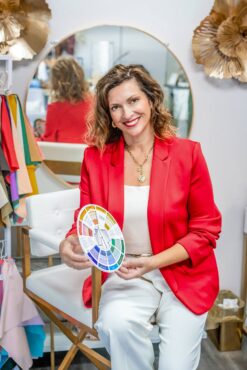
Imagine stepping into your closet each morning and feeling instantly inspired. Every piece of clothing works together effortlessly, creating a wardrobe that feels cohesive, stylish and — most importantly — uniquely you. This is the power of organizing your closet using color analysis, a system that not only streamlines your wardrobe but also ensures that every outfit makes you look and feel your best.
What Is Color Analysis?
Color analysis is a method used to determine which colors complement an individual’s natural skin tone, eye color and hair color. The goal is to identify a personalized palette of hues that enhance your natural features and bring out your radiance. This concept is broken down into seasonal color categories such as spring, summer, autumn and winter — each with its own range of warm or cool tones that flatter different individuals.
When applied to your closet, color analysis can be a game-changer. It helps eliminate wardrobe clutter, making it easier to put together outfits that naturally harmonize. The result? A closet filled with clothes that you love, wear often and feel amazing in.
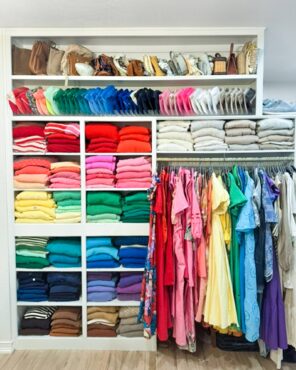
Step 1: Organize Your Closet by Color
The first step in transforming your closet is to organize your clothing by color. This simple yet effective technique allows you to see patterns, identify gaps and determine which colors dominate your wardrobe. As you arrange your clothes from light to dark within each color family, take note of which hues you gravitate toward and which ones feel underrepresented.
Sorting by color also helps you recognize the shades that make you feel powerful, confident and vibrant — and those that leave you feeling uninspired. If you’re unsure why certain colors don’t work for you, it may be due to their undertones. Colors that align with your natural undertones (warm, cool or neutral) will make your skin glow while those that clash can leave you looking washed out or dull.
For prints and patterns, identify the dominant color in each item and place it in the corresponding color section.
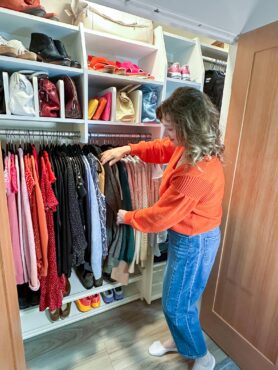
Step 2: Assess What Serves You
Now that your closet is color-coded, take stock of what truly serves you. Ask yourself:
- Which colors make me feel amazing when I wear them?
- Which pieces feel a little “off” but I’ve held onto anyway?
- What colors are missing that could help round out my wardrobe?
If certain colors consistently leave you feeling blah, they may not be in your ideal palette. That’s OK — this is part of the process. Understanding the difference between your “wow” colors and the ones to avoid will help guide future purchases and refine your wardrobe to its best version. Having a color palette as a guide will help you shop intentionally and strategically, ensuring that every new piece seamlessly integrates into your wardrobe and enhances your natural beauty.
Step 3: Build a Solid Foundation with Neutrals
A well-balanced wardrobe should be about 70% in your best neutrals. Neutrals serve as the backbone of your closet, making it easier to mix and match outfits effortlessly. Depending on whether you have a warm or cool undertone, your best neutrals will vary:
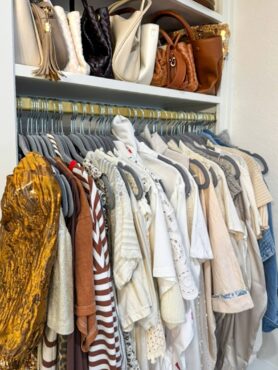
- Warm neutrals: camel, warm beige, chocolate brown, ivory, olive, warm gray
- Cool neutrals: charcoal, soft gray, navy, black, cool taupe, crisp white
Once you have a strong foundation of neutrals, adding pops of color from your personal palette becomes effortless. These accent colors bring energy and variety to your wardrobe while still working harmoniously with your core neutrals.
Step 4: Don’t Forget Shoes
and Accessories
A curated closet extends beyond clothing. Shoes, bags, scarves and jewelry should also align with your color palette. Organize these items in a way that makes them easy to access and coordinate with your outfits. Consider displaying your most-frequently worn pieces in an open area while storing seasonal items separately.
A clear system prevents clutter and ensures you’re making the most of what you own. Knowing your undertone will also help you determine your best metals for jewelry and eyewear — warm undertones tend to shine in gold, copper and bronze while cool undertones look stunning in silver, platinum and white gold.
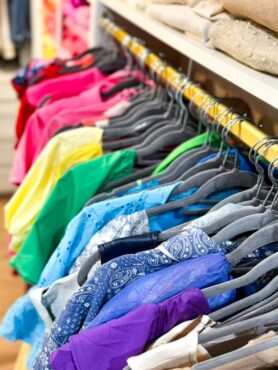
Step 5: Evaluate and Edit Regularly
At the start of each season, take time to refresh your closet. Ask yourself:
- What didn’t I wear last season?
- Why didn’t I reach for it?
- Can I style it in at least three different ways?
If a piece no longer fits your style, color palette or lifestyle, it may be time to let it go. Donate, resell or repurpose these items to keep your wardrobe intentional and organized. A seasonal refresh keeps your closet from becoming overwhelming and ensures that every piece continues to serve you.
A Closet That Works for You
A well-organized, color-coordinated closet is more than just visually pleasing — it’s a powerful tool for effortless style. By using color analysis to guide your wardrobe choices, you create a space filled with clothing that makes you look and feel incredible.
No more guesswork. No more closet full of “nothing to wear.” Just a carefully curated collection of pieces that support your best self, every single day.




























